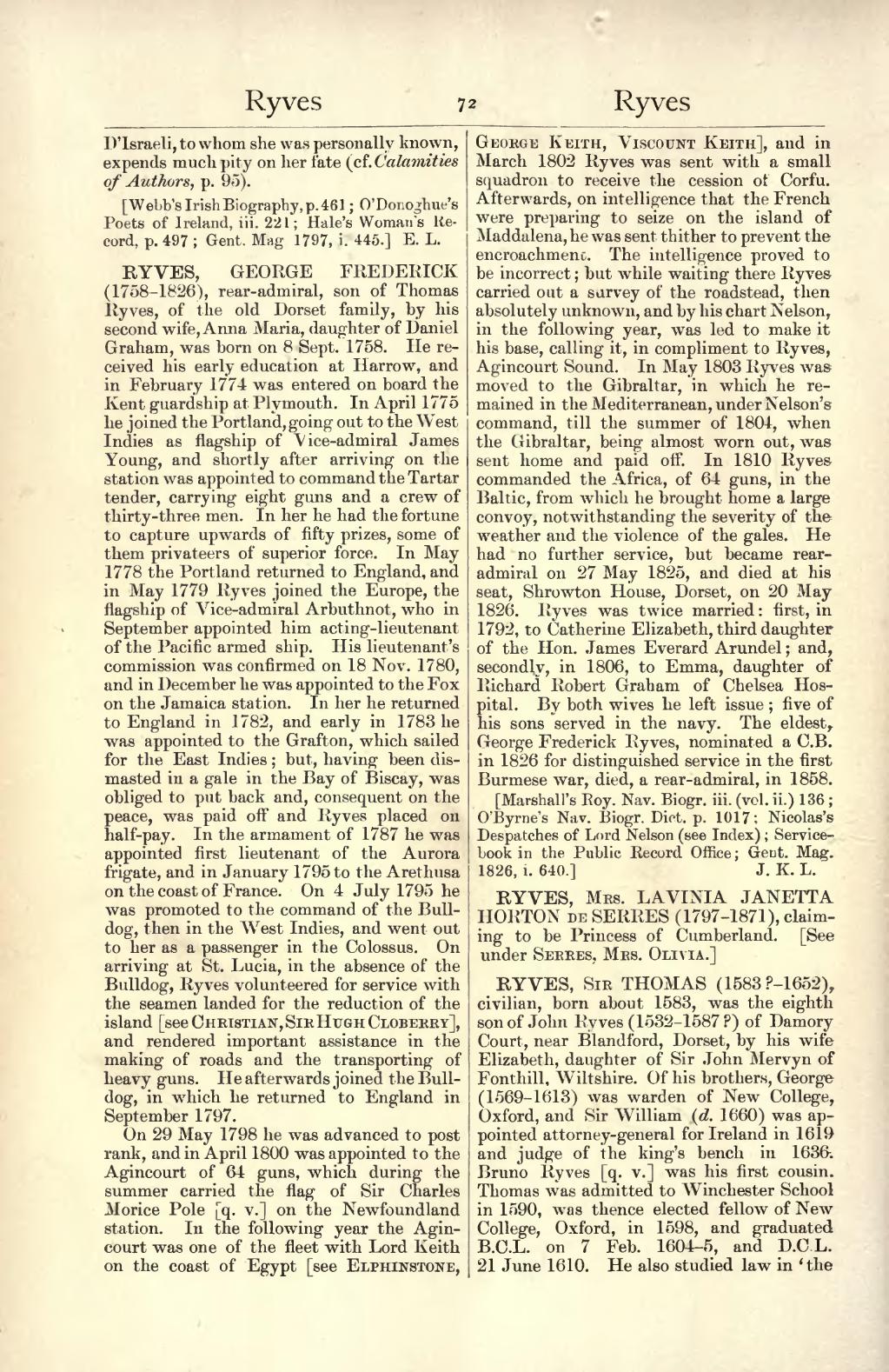D'Israeli, to whom she was personally known, expends much pity on her fate (cf. Calamities of Authors, p. 95).
[Webb's Irish Biography, p. 461; O'Donoghue's Poets of Ireland, iii. 221; Hale's Woman's Record, p. 497; Gent. Mag. 1797, i. 445.]
RYVES, GEORGE FREDERICK (1758–1826), rear-admiral, son of Thomas Ryves, of the old Dorset family, by his second wife, Anna Maria, daughter of Daniel Graham, was born on 8 Sept. 1758. He received his early education at Harrow, and in February 1774 was entered on board the Kent guardship at Plymouth. In April 1775 he joined the Portland, going out to the West Indies as flagship of Vice-admiral James Young, and shortly after arriving on the station was appointed to command the Tartar tender, carrying eight guns and a crew of thirty-three men. In her he had the fortune to capture upwards of fifty prizes, some of them privateers of superior force. In May 1778 the Portland returned to England, and in May 1779 Ryves joined the Europe, the flagship of Vice-admiral Arbuthnot, who in September appointed him acting-lieutenant of the Pacific armed ship. His lieutenant's commission was confirmed on 18 Nov. 1780, and in December he was appointed to the Fox on the Jamaica station. In her he returned to England in 1782, and early in 1783 he was appointed to the Grafton, which sailed for the East Indies; but, having been dismasted in a gale in the Bay of Biscay, was obliged to put back and, consequent on the peace, was paid off and Ryves placed on half-pay. In the armament of 1787 he was appointed first lieutenant of the Aurora frigate, and in January 1795 to the Arethusa on the coast of France. On 4 July 1795 he was promoted to the command of the Bulldog, then in the West Indies, and went out to her as a passenger in the Colossus. On arriving at St. Lucia, in the absence of the Bulldog, Ryves volunteered for service with the seamen landed for the reduction of the island [see Christian, Sir Hugh Cloberry], and rendered important assistance in the making of roads and the transporting of heavy guns. He afterwards joined the Bulldog, in which he returned to England in September 1797.
On 29 May 1798 he was advanced to post rank, and in April 1800 was appointed to the Agincourt of 64 guns, which during the summer carried the flag of Sir Charles Morice Pole [q. v.] on the Newfoundland station. In the following year the Agincourt was one of the fleet with Lord Keith on the coast of Egypt [see Elphinstone, George Keith], and in March 1802 Ryves was sent with a small squadron to receive the cession of Corfu. Afterwards, on intelligence that the French were preparing to seize on the island of Maddalena, he was sent thither to prevent the encroachment. The intelligence proved to be incorrect; but while waiting there Ryves carried out a survey of the roadstead, then absolutely unknown, and by his chart Nelson, in the following year, was led to make it his base, calling it, in compliment to Ryves, Agincourt Sound. In May 1803 Ryves was moved to the Gibraltar, in which he remained in the Mediterranean, under Nelson's command, till the summer of 1804, when the Gibraltar, being almost worn out, was sent home and paid off. In 1810 Ryves commanded the Africa, of 64 guns, in the Baltic, from which he brought home a large convoy, notwithstanding the severity of the weather and the violence of the gales. He had no further service, but became rear-admiral on 27 May 1825, and died at his seat, Shrowton House, Dorset, on 20 May 1826. Ryves was twice married: first, in 1792, to Catherine Elizabeth, third daughter of the Hon. James Everard Arundel; and, secondly, in 1806, to Emma, daughter of Richard Robert Graham of Chelsea Hospital. By both wives he left issue; five of his sons served in the navy. The eldest, George Frederick Ryves, nominated a C.B. in 1826 for distinguished service in the first Burmese war, died, a rear-admiral, in 1858.
[Marshall's Roy. Nav. Biogr. iii. (vol. ii.) 136; O'Byrne's Nav. Biogr. Dict. p. 1017; Nicolas's Despatches of Lord Nelson (see Index); Service-book in the Public Record Office; Gent. Mag. 1826, i. 640.]
RYVES, Mrs. LAVINIA JANETTA HORTON de SERRES (1797–1871), claiming to be Princess of Cumberland. [See under Serres, Mrs. Olivia.]
RYVES, Sir THOMAS (1583?–1652), civilian, born about 1583, was the eighth son of John Ryves (1532–1587?) of Damory Court, near Blandford, Dorset, by his wife Elizabeth, daughter of Sir John Mervyn of Fonthill, Wiltshire. Of his brothers, George (1569–1613) was warden of New College, Oxford, and Sir William (d. 1660) was appointed attorney-general for Ireland in 1619 and judge of the king's bench in 1636. Bruno Ryves [q. v.] was his first cousin. Thomas was admitted to Winchester School in 1590, was thence elected fellow of New College, Oxford, in 1598, and graduated B.C.L. on 7 Feb. 1604–5, and D.C.L. 21 June 1610. He also studied law in ‘the
